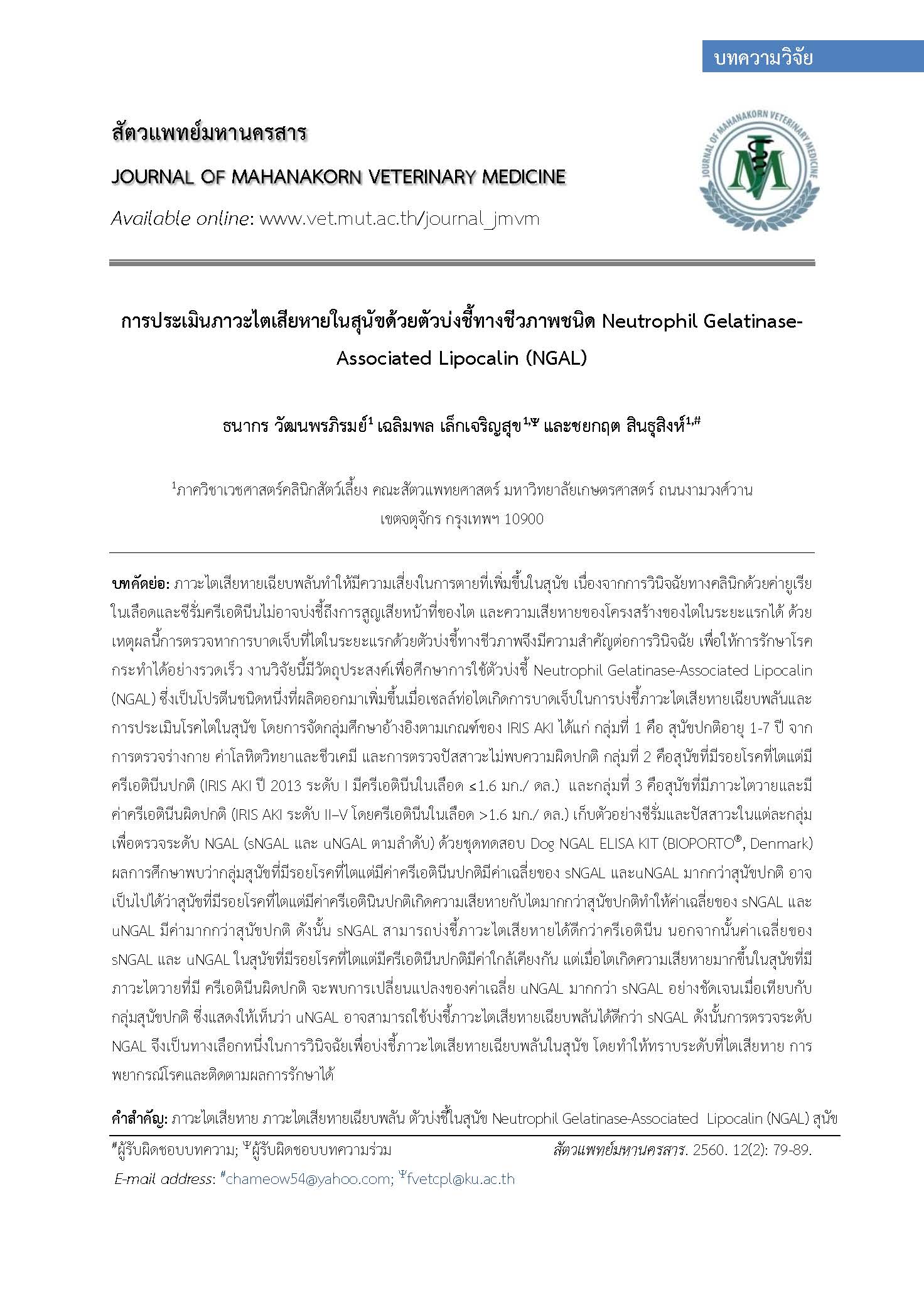The Detection of Kidney Injury in Dogs by Biomarker: Neutrophil Gelatinase-Associated Lipocalin (NGAL)
Main Article Content
Abstract
Acute kidney injury commonly causes the high risk of death in dogs because the clinical investigation by blood urea nitrogen and creatinine has failed to identify early stages of kidney dysfunction and structural injury. By this reason, there is important to use the biomarker for diagnosis of early kidney injury and immediate treatment. The objective of this research was to investigate the application of Neutrophil Gelatinase-Associated Lipocalin (NGAL) canine biomarker, a protein that is increasing when renal tubular cells damage resulted for the acute kidney injury and kidney diseases in dogs. The studied dogs were classified into three groups according to canine IRIS guidelines for grading AKI. Group 1 was defined as 1-7 years-old dogs without clinical or laboratory signs of AKI. Group 2 was defined as dogs with kidney injuries and normal creatinine values (IRIS AKI, 2013, grade I with serum creatinine ≤1.6 mg/dl). Group 3 was defined as renal failure dogs with elevated serum creatinine (IRIS AKI grade II–V with serum creatinine >1.6 mg/dl). Serum and urine samples were taken for NGAL evaluation (sNGAL and uNGAL, respectively) with Dog NGAL ELISA kit (BIOPORTO®, Denmark). The results found that the means of sNGAL and uNGAL in the dogs with kidney injuries and normal creatinine values were higher than normal dogs. It seems that the renal damages in the dogs with kidney injuries and normal creatinine values were severe than normal dogs. In this result, sNGAL could be effective to predict the acute renal injury better than creatinine level. Furthermore, the means of sNGAL and uNGAL were similar in the dogs with kidney injuries and normal creatinine values. Likewise, the level of uNGAL was increased more rapidly than the sNGAL level in dogs with renal failure and elevated serum creatinine compared to normal dogs. This indicated that uNGAL was better than sNGAL for evaluation of acute renal injury. This study showed that NGAL may serve as the marker for prediction of kidney injury, detection of different kidney diseases and evaluation of treatment outcome in dogs.
Article Details
References
Cowgill, L.D. and Langston, C.E. 2010. Acute kidney insufficiency. In: Bartges J, and Polzi, D. eds. Nephrology and Urology of Small Animals. Ames, IA: Blackwell Publishing Ltd: 472–523.
Devarajan, P. 2010. Review: neutrophil gelatinase-associated lipocalin: a troponin like biomarker for human acute kidney injury. Nephrology (Carlton) 15: 419– 428.
Frangogiannis, N.G. 2012. Biomarkers: hopes and challenges in the path from discovery to clinical practice. Transl. Res. 159: 197-204.
Hsu, W.L., Lin, Y.S., Hu, Y.Y., Wong, M.L., Lin, F.Y. and Lee, Y.J. 2014. Neutrophil Gelatinase–Associated Lipocalin in Dogs with Naturally Occurring Renal Diseases. J. Vet. Intern Med. 1-6.
Hvidberg, V, Jacobsen, C., Strong, R.K., Cowland, J.B., Moestrup, S.K. and Borregaard, N. 2005. The endocytic receptor megalin binds the iron transporting neutrophil-gelatinase-associated lipocalin with high affinity and mediates its cellular uptake. FEBS Lett. Jan 31. 579 (3): 773-7.
Kai, K., Yamaguchi, T., Yoshimatsu, Y., Kinoshita, J., Teranishi, M., and Takasaki, W. 2013. Neutrophil gelatinase-associated lipocalin, a sensitive urinary biomarker of acute kidney injury in dogs receiving gentamicin. J. Toxicol. Sci. 38: 269–277.
Langston, C.E. 2010. Acute uremia. In: Ettinger, S.J. and Feldman, E.C. eds. Textbook of Veterinary Internal Medicine. Philadelphia, PA: WB Saunders: 1955–2115.
Lee, Y.J., Hu, Y.Y. and Lin., Y.S. 2012. Urine neutrophil gelatinase associated lipocalin (NGAL) as a biomarker for acute canine kidney injury. BMC Vet Rec. 8: 248.
Linda, R. 2011. Acute Kidney Injury in Dogs and Cats. Vet. Clin. Small Anim. 41: 1–14.
McCullough, P.A., Shaw, A.D., Haase, M., Bouchard, J., Waikar, S.S., Siew, E.D., Murray, P.T., Mehta, R.L. and Ronco, C. 2013. Diagnosis of acute kidney injury using functional and injury biomarkers: workgroup statements from the tenth Acute Dialysis Quality Initiative Consensus Conference. Contrib Nephrol. 182: 13-29
Mori, K. and Nakao, K. 2007. Neutrophil gelatinase-associated lipocalin as the real-time indicator of active kidney damage. Kidney Int. 71: 967–970.
Nabity, M.B., G.E. Lees, R. Cianciolo, M.M. Boggess, J.M. Steiner and J.S. Suchodolski. 2012. Urinary biomarkers of renal disease in dogs with X-linked hereditary nephropathy. J. Vet. Intern Med. 26: 282-293.
Schmidt-Ott, K.M., Mori, K., Kalandadze, A., Li, J.Y., Paragas, N., Nicholas, T., Devarajan P. and Barasch, J. 2006. Neutrophil gelatinase-associated lipocalin mediated iron traffic in kidney epithelia. Current Opinion in Nephrology and Hypertension. 15: 442–449.
Schmidt-Ott, K.M. 2011. Neutrophil gelatinase-associated lipocalin as a biomarker of acute kidney injury-where do we stand today? Nephrol. Dial. Transplant. 26: 762–764.
Singer, E., Elger, A., Elitok, S., Kettritz, R., Nickolas, T.L., Barasch, J., Luft F.C. and
Schmidt-Ott, K.M. 2011. Urinary neutrophil gelatinase-associated lipocalin distinguishes pre-renal from intrinsic renal failure and predicts outcomes. Kidney Int. 80: 405–414.
Steinbach, S., Weis, J., Schweighauser, A., Francey, T. and Neiger, R. 2014. Plasma and Urine Neutrophil Gelatinase–Associated Lipocalin (NGAL) in dogs with acute kidney injury or chronic kidney disease. J. Vet. Intern Med. 1-6.


